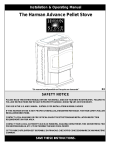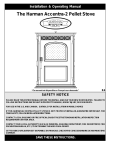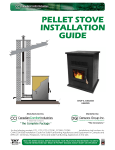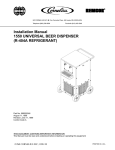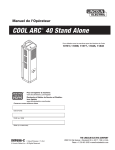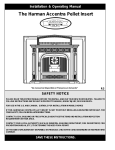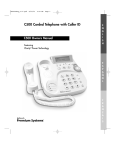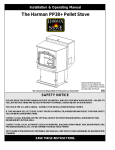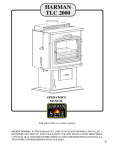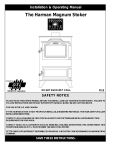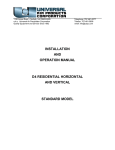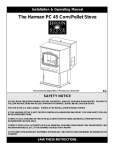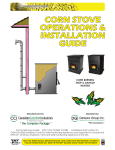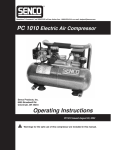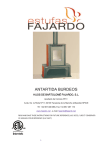Download Harman Stove Company P61A
Transcript
Installation & Operating Manual P61A-2 Pellet Stove Owners Manual Safety Testing by ASTM E1509 Mobile Home Approved R5 ìCe manuel est disponible en FranÁais sur demandeî SAFETY NOTICE PLEASE READ THIS ENTIRE MANUAL BEFORE YOU INSTALL AND USE YOUR NEW ROOM HEATER. FAILURE TO FOLLOW INSTRUCTIONS MAY RESULT IN PROPERTY DAMAGE, BODILY INJURY, OR EVEN DEATH. FOR USE IN THE U.S. AND CANADA. SUITABLE FOR INSTALLATION IN MOBILE HOMES IF THIS HARMAN STOVE IS NOT PROPERLY INSTALLED, A HOUSEFIRE MAY RESULT. FOR YOUR SAFETY, FOLLOW INSTALLATION DIRECTIONS. CONTACT LOCAL BUILDING OR FIRE OFFICIALS ABOUT RESTRICTIONSAND INSTALLATION INSPECTION REQUIREMENTS IN YOUR AREA. CONTACT YOUR LOCAL AUTHORITY (SUCH AS MUNICIPAL BUILDING DEPARTMENT, FIRE DEPARTMENT, FIRE PREVENTION BUREAU, ETC.) TO DETERMINE THE NEED FOR A PERMIT. CETTE GUIDE D'UTILISATION EST DISPONIBLE EN FRANCAIS. CHEZ VOTRE CONCESSIONNAIRE DE HARMAN STOVE COMPANY. SAVE THESE INSTRUCTIONS. R1 Fig. 1 2 P61A Pellet Stove Table of Contents Testing Lable 2 Assembly & Installation 4 Installation 5 Venting 6 Automatic Operation 12 ESP Control 16 Maintenance 17 Trouble Shooting 22 Feeder Parts 23 Specifications 23 Options 24 Wiring Diagram 26 Parts List 27 Warranty 28 Please read this entire manual before you install and use your new room heater. Failure to follow instructions may result in property damage, bodily injury, or even death. SUITABLE FOR MOBILE HOME INSTALLATIONS. Harman Stove Company 352 Mountain House Road Halifax, PA 17032 P61A Pellet Stove 3 Assembly and Installation Unpacking The P61 is bolted to the skid to prevent movement during shipping. To free the stove from the skid you must remove the hold-down bolts in the rear of the pedestal base. Removing or Installing rear cover panels To remove the rear cover panels, loosen the screws slightly and slide the covers outward as shown in the illustration. To reinstall, simply slide back into place and retighten the screws. Shipping Bolts Note: These same holes are used for mobile home installation Firebrick Install the firebrick vertically on the angle above the burnpot. Flame Guide Install the cast iron flame guide on top of the burnpot and make sure it is fully seated against the auger opening. The bottom of the flame guide is marked 38+. Rear Cover Panels Fig. 2 DO NOT INSTALL A FLUE DAMPER IN THE EXHAUST VENTING SYSTEM OF THIS UNIT. DO NOT CONNECT THIS UNIT TO A CHIMNEY FLUE SERVING ANOTHER APPLIANCE. INSTALL VENT AT CLEARANCES SPECIFIED BY THE MANUFACTURER Mobile home installation should be done in accordance with the Manufactured Home and Safety Standard (HUD), CFR 3280, Part 24. 4 P61A Pellet Stove WARNING DO NOT INSTALL IN SLEEPING ROOM CAUTION THE STRUCTURAL INTEGRITY OF THE MOBILE HOME FLOOR, WALL, AND CEILING/ROOF MUST BE MAINTAINED. CAUTION KEEP COMBUSTIBLE MATERIALS (SUCH AS GRASS, LEAVES, ETC.) AT LEAST 3 FEET AWAY FROM THE FLUE OUTLET ON THE OUTSIDE OF THE BUILDING. Installation Installing O R 9"-13" PR O TE CT O R 9" With Side Shields 13" Without Side Shields Fig. 3 1" 12" 6" 6" FLOOR PROTECTOR 6" With Side Shields 2" Fig. 4 18" FLOOR PROTECTOR Without Side Shields When installing this unit in a mobile home several requirements must be followed: 1. The unit must be bolted to the floor. This can be done with 1/4" lag screws through the 2 holes in the base plate. 2. The unit must also be connected for the outside air. See page 8. 3. Floor protection and clearances must be followed as shown. 4. Unit must be grounded to the metal frame of the mobile home. CAUTION: This appliance must be vented to the outside. Due to high temperatures, the stove should be placed out of traffic and away from furniture and draperies. Children and adults should be alerted to the hazards of high surface temperatures and should stay away to avoid burn to skin and/or clothing. Young children should be carefully supervised when they are in the same room as the stove. Clothing and other flammable materials should not be placed on or near this unit. Installation and repair of this Harman Stove should be done by a qualified service person. The appliance should be inspected before use and at least annually by a qualified service person. More frequent cleaning will be required. It is imperative that control compartments, burners, and circulating air passageways of the stove be kept clean. O Mobile Home Installation 9"-13" FL Place the stove on a noncombustible floor protector that extends 6 inches to the front, 6 inches to the sides and 1 inch to the rear of the stove. The minimum floor protector material is 24 gauge sheet metal. Place the stove away from combustible walls at least as far as shown in figures 3,4 and 5. Please note the difference in side wall clearance with and without side shields. Note that the clearances shown are minimum for safety but do not leave much room for access when cleaning or servicing. Please take this into account when placing the stove. Connect the power cord to a 120 V.A.C. 60Hz grounded receptacle. (A surge protector is recommened to protect the circuit board). Prior to installing the flue pipe, connect a draft meter to the stove as shown in fig. 6. (The draft meter must have a minimum range of 0-.5). However, prior to taking the draft reading be sure all doors and windows in the home are closed. Record the draft reading_______. If this reading is more than .05" lower than the unconnected reading, check for possible restrictions or the need for outside air (see page 7). Fig. 5 Fig. 6 P61A Pellet Stove 5 Venting Requirements for Terminating the Venting WARNING: Venting terminals must not be recessed into a wall or siding. NOTE: Only PL vent pipe wall pass-throughs and fire stops should be used when venting through combustible materials. NOTE: Always take into consideration the effect the prevailing wind direction or other wind currents will cause with flyash and /or smoke when placing the termination. In addition, the following must be observed: A. The clearance above grade must be a minimum of 18".1 B. The clearance to a window or door that may be opened must be a minimum of 48" to the side, 48" below the window/door, and 12" above the window/door.1 ( with outside air installed, 18î ) C. A 12" clearance to a permanently closed window is recommended to prevent condensation on the window. D. The vertical clearance to a ventilated soffit located above the terminal within a horizontal distance of 2 feet (60 cm) from the center-line of the terminal must be a minimum of 18". E. The clearance to an unventilated soffit must be a minimum of 12". F. The clearance to an outside corner is 11" from center of pipe. G. The clearance to an inside corner is 12". H. A vent must not be installed within 3 feet (90 cm) above a gas meter/regulator assembly when measured from the horizontal center-line of the regulator.1 I. The clearance to service regulator vent outlet must be a minimum of 6 feet.1 J. The clearance to a non-mechanical air supply inlet to the building or the combustion air inlet to any other appliance must be a minimum of 48î.1 K. The clearance to a mechanical air supply inlet must be a minimum of 10 feet.1 (with outside air installed, 6 feet ) L. The clearance above a paved sidewalk or a paved driveway located on public property must be a minimum of 7 feet.1,2 M. The clearance under a veranda, porch, deck or balcony must be a minimum of 12 inches.1,3 NOTE: The clearance to vegetation and other exterior combustibles such as mulch is 36î as measured from the center of the outlet or cap. This 36î radius continues to grade or a minimum of 7 feet below the outlet. 1 Certain Canadian and or Local codes or regulations may require different clearances. 2 A vent shall not terminate directly above a sidewalk or paved driveway which is located between two single †family dwellings and serves both dwellings. 3 Only permitted if veranda, porch, deck, or balcony is fully open on a minimum of 2 sides beneath the floor. NOTE: Where passage through a wall, or partition of combustible construction is desired, the installation shall conform to CAN/CSA-B365. (if in Canada) Inside Corner Detail Fixed Closed Openable Openable 6 V = Vent terminal P61A Pellet Stove A = Air supply inlet Fixed Closed = Area where terminal is not permitted Venting Venting IMPORTANT NOTICE Pellet Vent Pipe or PL Vent Pipe Must be used. A combustion blower is used to extract the combustion gases from the firebox. This causes a negative pressure in the firebox and a positive pressure in the venting system as shown in fig. 7. The longer the vent pipe and more elbows used in the system, the greater the flow resistance. Because of these facts we recommend using as few elbows as possible and 15 feet or less of vent pipe. The maximum horizontal run should not exceed 48". If more than 15 feet of pipe is needed, the diameter should be increased from 3" to 4" because a larger pipe causes less flow resistance. Be sure to use approved pellet vent pipe wall and ceiling pass through fittings to go through combustible walls and ceilings. Be sure to use a starting collar to attach the venting systen to the stove. The starting collar must be sealed to the stove with high temp silicone caulking. Vent Pipe Fig. 7 + = Positive static pressure = Negative static pressure Pellet venting pipe ( also known as PL vent ) is constructed of two layers with air space between the layers. This air space acts as an insulator and reduces the outside surface temperature to allow a clearance to combustibles of only 3 inches. The sections of pipe lock together to form an air tight seal in most cases; however, in some cases a perfect seal is not achieved. For this reason and the fact that the P61 operates with a positive vent pressure we specify that the joints also be sealed with clear silicone. Outside Air Outside air flex pipe goes here Flex pipe part# 2-00-08543 Inlet Cover part# 1-10-08543 Outside air is optional except in mobile homes and where building codes require. The benefit of outside air is mainly noticed in small very tight houses. To install outside air use 2 3/8" I.D. flex pipe part number 2-00-08543. There is a break-away hole on the rear panel which must be removed before connecting the flex pipe. The pipe should be run outside and terminate to the side or below the vent pipe outlet so the flue outlet is more than 12" from the inlet cover.The maximum length run of this pipe is 15 feet. If a longer run is needed the size must be increased to 3". Inlet cover part number 1-10-08542 should be used to keep birds, rodents etc. out of the pipe. HRV. When installing in a house with a Heat Reclaiming Ventilation System (HRV) be sure the system is balanced and is not creating a negative pressure in the house. P61A Pellet Stove 7 Venting #1 Preferred method This method provides excellent venting for normal operation and allows the stove to be installed closest to the wall. Two inches from the wall is safe; however, four inches allows better access to remove the rear panel. The vertical portion of the vent should be three to five feet high. This vertical section will provide natural draft in the event of a power failure. Fig. 8 3 ft. to combustibles #2 Preferred method This method also provides excellent venting for normal operation but requires the stove to be installed farther from the wall. The vertical portion of the vent should be three to five feet high and at least three inches from a combustible wall. This vertical section will provide natural draft in the event of a power failure. If the stove is installed below grade be sure the vent termination should be at least 1 foot above grade. CAUTION 3 ft. Fig. 9 8 P61A Pellet Stove to combustibles Keep combustible materials (such as grass, leaves, etc.) at least 3 feet away from the flue outlet on the outside of the building. Venting #4 Installing into an existing chimney ( US only ) This method provides excellent venting for normal operation. This method also provides natural draft in the event of a power failure. If the chimney condition is questionable you may want to install a liner as in method #7. Fig. 10 #5 Installing into an existing fireplace chimney ( US only ) This method provides excellent venting for normal operation. This method also provides natural draft in the event of a power failure. The damper area must be sealed with a steel plate or fiberglass. A cap should be installed on the chimney to keep out rain. If the chimney condition is questionable you may want to install a liner all the way to the top as in method #6. Fig. 11 P61A Pellet Stove 9 Venting #6 Installing into an existing fireplace chimney ( US and Canada ) This method provides excellent venting for normal operation. This method also provides natural draft in the event of a power failure. In Canada and some places in the US it is required that the vent pipe extend all the way to the top of the chimney. In this method a cap should also be installed on the chimney to keep out rain. Be sure to use approved pellet vent pipe fittings. Seal pipe joints with silicone in addition to the sealing system used by the manufacturer. Pipe size should be increased to 4" using this method. Fig. 12 #7 Installing into an existing chimney ( US and Canada ) This method provides excellent venting for normal operation. This method also provides natural draft in the event of a power failure. In Canada and some places in the US it is required that the vent pipe extend all the way to the top of the chimney. The pipe or liner inside the chimney should be 4"diameter. In this method a cap should also be installed on the chimney to keep out rain. One disadvantage of this method is that it is harder to clean the vent pipe, therefore, there is a tendancy not to do it as often as needed. 10 P61A Pellet Stove Fig. 13 Venting 12" min. Storm collar Flashing 3" min. PL vent manufacturer's firestop spacer and support 3" min. No insulation or other combustible materials are allowed within 3" of the PL vent pipe. Minimum flue vent configuration It is recommended that outside air be installed with this venting configuration. (See Page 9 for c o r n e r installation clearances) 18" Fig. 14 #8 Installing through the ceiling vent Through the ceiling vent, follow PLvent manufacturers recommendations when using wall and ceiling pass through. Fig. 15 Min. above ground level 3" min. Fig. 16 P61A Pellet Stove 11 P61A-2 AUTOMATIC IGNITION/OPERATION o o The P61A pellet stove is more than just automatic ignition, it is also automatic temperature control. The automatic system will allow the fire size to be adjusted to match the heating needs and even put the fire out if necessary. If heat is needed after the fire is out, the P61A will automatically re-ignite and adjust the fire size to match the heating need. The totally automatic room sensor mode is recommended because of its efficiency. The unit can be switched between "AUTO" and "MANUAL" at any time during operation. Ignitor switch to "AUTO" Room Temperature Mode Room Temperature Mode: This setting will produce a room temperature of 70 degrees with the distribution blower at medium speed. Stove Temperature Mode In "Room Temp Mode" heat output is controlled automatically by the Room Sensing Probe. When the Room Sensing Probe calls for heat, the stove will increase output. When the Room Sensing Probe is getting close to the set temperature, the stove will begin to level off output and keep the fire burning at just the right temperature to maintain that setting. High output is determined by the feed rate setting. This setting, generally on #4, can be increased if higher burn rates are necessary. The unit's maximum burn rate should not create less then 1" of ash on the burn pot front edge. See Fig.2. Overfeeding is not a safety concern, but fuel may be wasted if unburned pellets fall into the ash pan. In "Room Temp Mode" a constant fuel consumption rate is sacrificed for exact room temperature. Therefore, as it gets colder more pellets will be burned automatically. The distribution blower speed will vary according to the position of the mode selector pointer, and fire size. Ignitor switch to "AUTO" Stove Temperature Mode This setting will produce medium heat with the distribution blower on "low". This allows for automatic ignition upon start-up only. The unit can then be set at any desired setting. The heat output and fuel consumption will remain constant regardless of room temperature. The unit's maximum feed rate should not create less than 1" of ash on the burn pot front adge. See Fig 2. The unit's low burn or maintenance setting is as low as it will go. It will not go out unless it runs out of fuel or is turned off. Shut-Down Procedure This setting will produce continuous maximum heat output with the distribution blower at full speed. 12 P61A Pellet Stove To kill the fire or stop burning the stove, turn the Mode Selector to "OFF". This will cause the fire to diminish and burn out. When the fire burns out and the stove cools down everything will stop. If you pull the plug to shut down the stove, all motors will stop. This may cause incomplete combustion and smoke in the firebox. If the load door is opened the smoke may escape. The best way to shut down the stove is simply let it run out of pellets, then the stove will shut down automatically. P61A-2 AUTOMATIC START UP Starting First Fire Ignitor Switch to"AUTO"(up position) Make sure the unit is plugged into a 120 VAC, 60 HZ electrical source. The power light should be the only light lit. See Note 7. 1" Fig. 17 Fig. 18 1. Fines are small pieces of broken pellets (sawdust). Fines do not flow easily and often build up on the hopper funnel bottom angles. These fines can be pushed into the feeder opening and then fill the hopper with pellets. As the system works, they will be burned. 2. The "TEST" cycle will operate the feeder motor for exactly one minute. Turning to "TEST" again and again may purge too much fuel into the burn pot causing excessive smoke on start-up. 3. The firebox low pressure switch will not allow the auger motor or the igniter element to operate if the view door or the ash pan door are open. 4. Adjust Feed Rate. If this is your first fire or you are trying different pellets, set the feed adjuster to #4, Fig. 17. This is a conservative number and will probably need to be increased. After you know a feed rate setting that works well, use that setting. Remember, if your feed rate is too high you may waste fuel. 5. This is usually a weekly maintence procedure. Cleaning the burn pot with the scraper with a small amount of new fuel in the bottom is not a problem. First, scrape the ashes on the front of the burn pot into the ash pan. Then scrape the holed surface downward into the burn pot. When the stove is ignited these scrapings will be pushed out by the feeder. 6. The ash pan can hold the ashes from approximately 1 ton of premium fuel. This means the ashes will only need to be emptied a few times a year. 7. Setting the feed adjuster # for maximum burn: With the unit burning in "AUTO", turn to "Stove Mode" and put the fan on "H". Set the Temperature Dial to #7. Allow the unit to burn for about 30 minutes and check ash on front of burn pot. Fig. 18. If the ash line is larger than 1", turn the feed adjuster from #3 to #4. Allow another 30 minutes of burn time and check again. If , at #6 setting, a 1" or less ash bed is not obtainable, it is not a problem. The 1" ash bed is only a maximum burn rate and at most normal settings the ash bed will be larger. NOTICE: When power is given to the stove, the control board will blink a few times to indicate current version of control board. 1. Turn Mode Selector to "OFF". 2. Fill hopper with pellets.1 3. Clean burn pot with scraper, if necessary.5 4. If starting after an empty hopper, turn Feed Adjuster to "TEST" (for one 60 second cycle).2 This will purge pellets into the auger tube and also allow you to check the motors for operation. NOTE: The auger motor will not operate with the view door or ash pan door open.3 5. Turn Feed Adjuster to #4.4 6. Flip the Ignitor Switch up into the "AUTO" position. 7. Turn the Temperature Dial to desired room temperature. 8. Turn Mode Selector to Room Temperature or Stove Temperature. 9. Fill hopper with pellets and remove ashes as required.6 Warning "NEVER USE GASOLINE, GASOLINE-TYPE LANTERN FUEL, KEROSENE, CHARCOAL LIGHTER FLUID, OR SIMILAR LIQUIDS TO START OR "FRESHEN UP " A FIRE IN THIS HEATER. KEEP ALL SUCH LIQUIDS WELL AWAY FROM THE HEATER WHILE IN USE". P61A Pellet Stove 13 P61A-2 MANUAL IGNITION/OPERATION o o The P61A Pellet Stove is capable of manual operation. This also allows the operator to manually control operation during an emergency (i.e. ignitor failure, when using a 502H battery backup, or when using certain generators.) The unit can be switched between "AUTO" and "MANUAL" at any time during operation. NOTE: When starting the unit in the "AUTO" mode and switching to "MANUAL", the fire must be large enough to start the distribution blower. The starting of the blower is a signal that the start cycle is completed and the fire will not go out. Ignitor Switch to "MANUAL" Room Temperature Mode Room Temperature Mode: This setting will produce a room temperature of 70 degrees with the distribution blower at medium speed. Manual Stove Temperature Mode The fire will have to be lit with starting gel and a match, or started automatically, see "Automatic Operation". Turn to "Manual" position when the fire is established. The difference between "AUTO" Room Temperature Mode and "Manual" Room Temperature Mode is that the fire will not go out as the room temperature goes above the control board setting. The unit can only go to low burn and will remain there until it runs out of fuel or until more heat is needed and the feed rate increases. Feed rate adjustments and dial settings are the same as "AUTO" settings. Ignitor Switch to "MANUAL" Stove Temperature Mode The advantage of this mode is to allow the operator to have a large viewing fire without blowing extra heat into the room. During operation, with the temperature dial set at #5 or less, the distribution fan will not operate. A #5 on the temperature dial and a #5 on the feed adjuster is approxiO mately 80% output. It is not necessary to operate the distriO O bution blower below this point. Therefore, there can be a O higher feed rate ( a larger viewing fire) without an excess of hot air blowing into the room. An example of when to use the Manual Stove Temperature Mode is if you want to watch a large fire and the room is aleady up to temperature. The Stove Temperature Mode allows you to have a larger fire and a lower sound level, without the distribution blower. NOTE: During the use of this mode, if you keep increasing the temperature dial setting to increase the fire size, the distribution blower will automatically come This setting will produce a large viewing fire without on when the ESP Temperature reaches 350o F, or 81% a distribution blower operating. output. 14 P61A Pellet Stove P61A-2 MANUAL START UP Fig. 20 Fig. 19 See Note 7. 1" Fig. 21 1. Fines are small pieces of broken pellets (sawdust). Fines do not flow easily and often build up on the hopper funnel bottom angles. These fines can be pushed into the feeder opening and then fill the hopper with pellets. As the system works, they will be burned. 2. The "TEST" cycle will operate the feeder motor for exactly one minute. Turning to "TEST" again and again may purge too much fuel into the burn pot causing excessive smoke on start-up. 3. The firebox low pressure switch will not allow the auger motor or the igniter element to operate if the view door or the ash pan door are open. 4. Adjust Feed Rate. If this is your first fire or you are trying different pellets, set the feed adjuster to #4, Fig. 19. This is a conservative number and will probably need to be increased. After you know a feed rate setting that works well, use that setting. Remember, if your feed rate is too high you may waste fuel. 5. This is usually a weekly maintence procedure. Cleaning the burn pot with the scraper with a small amount of new fuel in the bottom is not a problem. First, scrape the ashes on the front of the burn pot into the ash pan. Then scrape the holed surface downward into the burn pot. When the stove is ignited these scrapings will be pushed out by the feeder. 6. The ash pan can hold the ashes from approximately 1 ton of premium fuel. This means the ashes will only need to be emptied a few times a year. 7. Setting the feed adjuster # for maximum burn: With the unit burning in "AUTO", turn to "Stove Mode" and put the fan on "H". Set the Temperature Dial to #7. Allow the unit to burn for about 30 minutes and check ash on front of burn pot. Fig. 21. If the ash line is larger than 1", turn the feed adjuster from #3 to #4. Allow another 30 minutes of burn time and check again. If , at #6 setting, a 1" or less ash bed is not obtainable, it is not a problem. The 1" ash bed is only a maximum burn rate and at most normal settings the ash bed will be larger. Starting First Fire Ignitor Switch to"MANUAL" (down position) Make sure the unit is plugged into a 120 VAC, 60 HZ electrical source. The power light should be the only light lit. 1. Turn FEED ADJUSTER to desired feed rate. No. 4 is good for most pellets.4 2. Turn the MODE SELECTOR to ìOFFî and then to the desired mode. This will reset control and start the combustion motor. 3. Turn the TEMPERATURE DIAL to the desired setting. 4. Clean burn pot with scraper if necessary.5 5. Fill burn pot with pellets, only level with front edge. (Do Not Over Fill). 6. Add starting gel on top of the pellets. Stir gel into pellets for fast lighting. 7. Light starting gel with a match, and close the door. Operation will begin when the fire reaches the proper temperature.3 8. Fill hopper with pellets and remove ashes as required.1, 6 Warning "NEVER USE GASOLINE, GASOLINE-TYPE LANTERN FUEL, KEROSENE, CHARCOAL LIGHTER FLUID, OR SIMILAR LIQUIDS TO START OR "FRESHEN UP " A FIRE IN THIS HEATER. KEEP ALL SUCH LIQUIDS WELL AWAY FROM THE HEATER WHILE IN USE". P61A Pellet Stove 15 P61A-2 AUTOMATIC IGNITION ESP CONTROL Power Light Indicates power to the control. Feed adjuster Sets the maximum feed rate Status Light Will be lit in either stove or room temp mode when pointer is not within off position band except after normal shut down. Blinks to indicate errors listed below. O Test Runs all motors at full speed for one minute to check operation. After two minutes the stove will go to minimum burn and the blowers will alternate from high to low every minute to remind you that you are still in "Test Mode". O Ignitor switch Set to appropriate Start-Up mode. Indicates power to distribution blower. Distribution Blower speed adjustment range. L = low H = high Variable speed anywhere between L and H; although as the stove temp. goes up , so does the L and H scale. Indicates power to combustion blower Indicates power to the feed motor. Indicates ignitor is on. Temp dial Allows you to adjust the room temperature in Room Temp Mode using the outer scale marked in degrees Fahrenheit. It also allows you to adjust the stove temperature while in Stove Temp Mode using the inner scale marked from 1 to 7. Dealer Diagnostic Port For dealer maintenance only. Requires special DDM monitor supplied to Harman Dealers exclusively. Status light error messages: 1 Blink: Indicates control board self diagnostic failure. This requires a manual reset*. 2 Blinks: Indicates that the jumper (J2) on the rear of the control board is not connected. Without this jumper the unit will only burn at minimum rate. 3 Blinks: Indicates ESP (Exhaust Sensing Probe) failure. This requires a manual reset*. 4 Blinks: Can occur only in Room Temp Mode and indicates Room Sensing Probe failed or not installed. If a Room Sensing Probe is then installed, the status light will automatically reset. 5 Blinks (In Igniter Auto. Mode Only): Indicates that the unit has failed to light within the 36 minute start cycle. To reset - Turn Mode Selector to "OFF", then 16 turn to either mode again.) P61A Pellet Stove Mode Selector Allows you to choose between Room Temp Mode, Stove Temp Mode, or OFF. Also allows you to vary the distribution blower speed by turning the knob to the high or low side of each mode. 6 Blinks : Indicates that the control has calculated poor or incomplete combustion occurring for more than 50 minutes. A six blink status may be set if the stove is allowed to run out of pellets. To reset, turn mode selector to "OFF" then back on to the desired mode. If the unit was not out of pellets, see Troubleshooting section for more details. * Manual reset- disconnect power cord for a few seconds and reconnect. If error still occurs call your Dealer. NOTICE: When power is given to the stove, the control board will blink a few times to indicate current version of control board. This should not be confused with error messages. P61A-2 Low Draft Voltage Adjustment Combustion Motor Speed Control Low draft only set point. The small straight screwdriver slot is plastic; therefore, the unit can be adjusted while in operation. Fig.22 Draft Meter bolt hole location On a P61A the draft hole is under the left rear corner of the firebox. Fig. 23 Fig.1 Low Draft Voltage Adjustment These units are pre-tested at the factory with exactly 120 Volts A.C., 60 Hz. They are checked and adjusted for firebox tightness, gasket leakage, motor operation and ignitor operation. The P61A is then factory set at a mid-point adjustment and in most cases will not need any adjustments. NOTE: The factory low draft setting may not be correct for the units permanent installation conditions. The control board on the P61A is equipped with a low draft adjustment port. Located on the control face just to the right of the igniter light. This voltage adjustment is provided to allow the unit to be adjusted for the household voltage where the unit is going to be in permaneant operation. NOTE: The line voltage varies from area to area and often home to home. The low draft voltage should be adjusted to achieve the most efficient burn on low burn or "maintenance". This voltage adjustment allows the installer to change the low voltage set point approximately 10 volts. This adjustment should be done by the installer during set up because a draft meter reading is required to insure proper set up. If the unit is not adjusted properly, it does not cause a safety concern. If the unit is adjusted too high, only effiency is lost. If the unit is adjusted too low, the low draft pressure switch will not allow the feeder motor or the igniter to operate. A simple draft test should be performed after completing the flue pipe installation. To record the results for future reference: 1. Plug unit into a 120VAC, 60 HZ outlet. 2. Close the hopper lid, front view door, and the ash pan. Neither pellets or a fire are required for this test. 3. With the mode selector in the "OFF" position, turn the feed adjuster to "TEST". 4. Record the high draft_____in W.C. (Normal is -.50 to .60) The control will be on the High Draft for a total of 2 minutes. 5. After 2 minutes is up, the combustion motor will go down to low draft and the distribution blower will go on high. Allow approximately 15 seconds to pass for the combustion motor to slow before checking the low draft. 6. If the low draft is between -.35 and -.45, record the reading _____ in W.C. If the reading is higher, slowly turn the set screw counter-clockwise until the draft lowers. If the reading is lower, very slowly turn the set screw clockwise until the draft increases. NOTE: The test mode alternates from high to low draft every 60 seconds. If more time is needed for draft adjustment, wait until the next low draft cycle. NOTE: In some cases, the draft may not go as low as -.35 to -.45 even with the set screw completely counterclockwise. P61A Pellet Stove 17 Room Sensor and Rear Shield Installation Rear Shields Room Sensor Installation 5/16" Hex Head Screws (2 on each side) Fig. 24 The room sensor is a small temperature sensor on the end of a 60" gray wire. This sensor is installed much like a standard wall thermostat. Because it is so small, it can be hidden along the trim of a doorway or even up the leg of a coffee table. There is a remote room sensor port on the rear of the unit for easy external connection. Use standard 18-2 thermostat wire to extend the distance to the desired location (100' maximum). The room sensor should be installed in the location where you want to control the temperature. NOTE: Distances of more than 25 feet from the unit or in another room are not recommended. The room sensor is essential for the P61A's excellent efficiency. NOTE: It is recommended that the room sensor be installed, even if only installed on the rear of the unit as a return air sensor. 18 P61A Pellet Stove 5/16" Hex Head Screws (2 on each side) Fig. 25 The rear isolated shields are split in the middle for easy removal. Each shield has two 5/16" hex head screws that only need to be loosened (NOT REMOVED) to allow the shield to slide away from the unit. NOTE: It is not recommended that the unit be operated with the shields removed, due to the hot and moving parts which they protect. Maintenance Removing Ashes: When approximatly 1 ton of pellets has been burned it will be necessary to empty the ash pan. Ashes should be placed in a metal container with a tight fitting lid. The closed container of ashes should be placed on a noncombustible floor or on the ground, well away from all combustible materials, pending final disposal. If ashes are disposed of by burial in soil or otherwise locally dispersed, they should be retained in the closed container until all cinders have thoroughly cooled. It is recommended that the stove is cold and shut down when removing ash pan. 1. Pull on latch handle and remove ash pan as shown at left. Use ash pan handle to carry and dispose of ashes. 2. Slide the ash pan back into the stove and latch by pushing in on latch handle. Blower Cover Latch Combustion Blower Cover Fig 26 Cleaning: The stove will need to be cleaned for approximately every 2 to 5 tons of pellets burned. The amount of pellets burned before cleaning will vary depending on the brand of pellets. Heat Exchanger Fins 1. Shut down stove and disconnect power cord to insure that all motors are stopped. 2. Remove ash pan as described earlier. 3. Remove combustion blower cover by turning the blower cover latch vertical as shown in Fig.26 and sliding the cover out of the slot on the left.This will expose the combustion blower wheel and flue outlet, Fig.27. Scraper 4. Clean the blower wheel with a brush and a vacuum cleaner. 5. Use a brush to clean the flue, being careful not to damage the ESP probe. The flue goes straight through into the vent pipe (Fig.27) therefore, the Blower Cover vent pipe can also be cleaned to some extent Latch through the flue outlet. Flue Outlet Blower Wheel Fig 27 6. Reinstall blower cover and relatch. P61A Pellet Stove 19 Maintenance Clean-out plate 7. Open burn pot clean-out as shown to the left, clean fly ash from burn pot and replace cover. 8. Clean heat exchanger with scraper as shown in fig 25. 9. Brush or scrape the inside of the stove to remove fly ash. Fig. 28 Latch "closed "with blower cover in place. Burn pot clean-out is closed. Fig. 29 Latch "open "with blower cover partly removed. Burn pot clean-out is open. 11.Slide ash pan into stove and latch into place. Brush not supplied. Can be found in hardware stores. Fig. 32 ESP probe Fig. 30 Exposed blower wheel and flue opening, NOTE: ESP probe is visible. 10. Scrape burnpot with flat end of scraper provided with the stove. Fig. 33. Blower cover removed. Soot and Fly Ash The products of combustion will contain small particles of fly ash. The fly ash will collect in the exhaust venting system and restrict the flow of the flue gases. Incomplete combustion, such as occurs during startup, shutdown, or incorrect operation of the room heater, will lead to some soot formation which will collect in the exhaust venting system. The exhaust venting system should be inspected at least once every year to determine if cleaning is necessary. ESP Probe Fig. 31 20 P61A Pellet Stove Be careful not to damage ESP probe when cleaning with brush. Fig. 33 P61A-2 Maintenance - Burn Pot Burn Pot Cleaning and Maintenance 1. Scrape the top holed surface and sides of the burn pot.(Fig 34) It is not necessary to completely remove all material from the burn pot. The excess will be pushed out during the next use. 2. Loosen the (2) wing thumb screws on the lower front angle of the burn pot. (Fig. 34) 3. Lift off the clean-out cover (Fig.35) to open the bottom clean-out chamber. (Fig.36) DANGER Disconnect the power to the unit before removing cover. Fig. 34 4. Clean ash buildup from inside the chamber while cover is off. Use the scraper to tap on the top front edge of the burn pot. This will help knock pieces of ash, loosened by the scraping process, down through the holes. It also helps knock scale off of the ignitor element. Figure 36 The ignitor is made to be removable for service by insulated male/female wire connectors. These connections between the hot leads (the wires inside the burn pot) and the cold leads (the wires from the control board) are always pulled to the inside rear of the feeder body. (Not coiled inside the burn pot.) It is very important that these connections are to the inside rear of the feeder body. Also, the extra wire of the ignitor wire service loop must be pulled out through the rear of the feeder and tied up so that it will not be damaged by any moving parts. Fig. 35 Burn pot ignitor DANGER Disconnect the power to the unit before removing cover. Warning Use caution when cleaning burn pot clean-out chamber. Do not damage the high temperature igniter wires. Ignitor hot lead wires (high temperature) Fig. 36 Viewed from below throught the ash pan opening. Note: The hot lead/cold lead connection must always be pulled to the rear of the feeder body before operation. P61A Pellet Stove 21 P61A-2 Trouble-Shooting 5. Power failure or blown fuse. FEEDER DOES NOT FEED 1. No pellets in hopper. SMOKE IS VISIBLE COMING OUT OF VENT 2. Firebox draft may be too low for low draft pressure 1. Air-fuel ratio is too rich. switch in feeder circuit to operate. Check for closed A. Feed rate too high. doors, loose or missing gasket on doors or hopper lid, B. Draft too low caused by a gasket leak. faulty pressure switch. 3. Feed motor will not run until ESP LOW HEAT OUTPUT senses 165 deg. F. Maybe you did not put 1. Feed rate too low enough pellets in the burn pot before lighting the fire. 2. Draft too low because of gasket leak. 4. Something is restricting flow in the hopper or caus3. Poor quality or damp pellets ing the slide plate to stick. 4. Combination of 1. and 2. 5. Feed motor has failed. PARTIALLY BURNED PELLETS Helpful Hints 1. Feed rate too high. Cleaning Burn Pot 2. Draft too low. (Check burn pot clean out slide and Whenever your stove is not burning, take the opdoor gasket). portunity to scrape the burn pot to remove carbon 3. Burn pot or heat exchanger tubes may need to be buildup. A vacuum cleaner is handy to remove the resicleaned. due. Be sure the stove is cold if you use a vacuum. 4. Combination of all the above. Carbon buildup can be scraped loose with the fire 5. #6 status blink: A 6 blink control board status indiburning using the special tool provided with your stove. cation is caused by poor or incomplete combustion. The Automatic Ignition circuit board has the ability to Scrape the floor and sides of the burn pot. The carbon track the combustion through feed settings and ESP will be pushed out by the incoming fuel. Always wear temperatures. When the control board has calculated gloves to do this. poor or incomplete combustion it will shut down the unit as a safety feature. (Poor or incomplete combus- Removing Ashes Turn the Temp Dial to number 1 approximately tion is a contributer of creasote which may cause a 30 minutes before removing ashes. This will result in a chimney fire) cooler stove and ash pan. A 6 blink status may be caused by several things: Maximum Feed Adjuster settings are not needed 1. Blocked or partially blocked flue. in most cases. Operating in the normal range (#4) is 2. Blocked or partially blocked inlet air. a. backdraft damper on the inlet pipe may be stuck recommended when maximum heat output is not required. The ESP probe prevents the stove from being closed. over-fired. b. if outside air is installed the inlet cover may be Keep the stove free of dust and dirt. blocked. 3. The air chamber under the burnpot may be filled with fines and small bits of ash. Fuel 4. The holes in the burnpot may be getting filled with ash or carbon buildup. Pellet fuels are put into 3 categories in terms of ash 5. Combustion blower fan blades may need cleaned. content. Premium at 1% or less, Standard at 3% or less 6. No fuel in hopper. and all others at 3% or more. SMOKE SMELL The P61A is capable of burning all 3 categories of Seal the vent pipe joints and connection to stove with pellets due to a patented feeder and burn pot system. silicone. It should be noted, however, that higher ash conFIRE HAS GONE OUT tent will require more frequent ash removal and may 1. No pellets in hopper. provide less BTU's per pound. Normally, standard and high ash pellets cost less than premium pellets and can 2. Draft setting is too low. be cost effective when burned in the P61A. 3. Something is restricting fuel flow. The moisture content must not exceed 8%. Higher 4. Feed motor or draft motor has failed. moisture will rob BTU's and may not burn properly. 22 P61A Pellet Stove P61A Feeder P61A-2 Feeder and Specifications Specifications 32.375" 34.5" 12.375" 23.5" 9" Weight Blower Feed Rate Hopper Capacity Fuel Flue Size Outside Air Size Fuse Rating 249 lbs. 135 cfm .75 to 7.5 lbs. per hr. 72 lbs. Wood Pellets 3 inch 2 3/8 I.D. inch 5 amp 29.5" 5.250" P61A Pellet Stove 23 Door Options Optional Trim Decorative Tile To install, lay the frame face down on a soft surface. Fasten door frame by inserting the 4 threaded posts on the frame through the door. The posts should line up with the 4 holes located at the corners of the door. Once the posts are through the door, fasten frame with 4 nuts and tighten until the frame is snug. To install ash lip trim, simply slide the trim over the ash lip and into the groove on the trim. Decorative tile is available in several configurations. The tile installs behind the trim on the ash door. Cleaning Plated Trim Gold or nickel plated hardware should never be buffed or polished. Abrasive cleansers and metal polishes will remove the plating and therefore should never be used. If the plating needs to be cleaned, wait until the stove is completely cool, then use a sponge, soap and water to gently remove dirt and stains. Before relighting the stove, remove all soap residue and wipe dry. 24 P61A Pellet Stove OPTIONS Side Heat Shields Hopper Extension Side heat shields are available to reduce The hopper extension allows you to the clearance to combustible materials. put more pellet fuel in the hopper and extends burn time on one load of pellets. The hopper extension adds 60 pounds to the existing 72 pound hopper capacity, allowing you to load 132 pounds of pellets at one time. P61A Pellet Stove 25 P61A-2 Wiring Diagram 26 P61A Pellet Stove P61A-2 Parts List Description Part Number Hopper Gasket(6 ft.) 0-88-00248 Ash Pan Assembly 1-10-05800 Burn Pot Weldment 1-10-05802 Right Rear Shield 2-00-06468-1 Left Rear Shield 2-00-06468-2 Arrow Scraper 2-00-773850 Flame Guide 3-00-08534 Wiring Harness Assembly 3-20-08727 Thermister Probe 3-20-00744 Room Sensor 3-20-00906 Circuit Board 3-20-05374 Differential Switch 3-20-9301 5" Double Fan Blade 3-20-502221 Combustion Blower 3-21-08639 Distribution Blower 3-21-22647 Hopper Lid Latch 3-31-199110 3/16" Rubber Washer (for Hopper Lid) 3-31-90131101 Power Cord 3-20-29685 Auto Ignite Label (Control Panel Door)3-90-08627 Fire Brick (3) 3-40-900450125 White/Black Control Knob(3) 3-31-00605 Control Knob Shaft(3) 3-31-00015 Front Glass 3-40-950133125 Burn Pot Gasket(2) 3-44-00409 Tailpipe Gasket 3-44-06179 Wiring Diagram 3-89-06504 Control Panel Sticker 3-90-06655 Owner's Manual 3-90-05822 Hopper Lid Label 3-90-08416 Igniter Assembly 1-10-06620 Cleanout Cover(1) 2-00-06623 1/4-20 x 1/2" Wing Screw w/Collar(2) 3-31-782108 Options: Hopper Extension Assembly 1-00-08636 Outside Air Assembly 1-10-08542 Inlet Cover 1-10-08543 3' Flex Pipe 2-00-08543 Log Set 3-40-5647 Trim Kit 1-00-06802 Tile Pack(1 piece) 3-43-12601(10 choices) P61A Pellet Stove 27 Harman Gold Warranty HARMAN GOLD WARRANTY 6 YEAR TRANSFERABLE LIMITED WARRANTY (Residential) 1 YEAR LIMITED WARRANTY (Commercial) Harman Stove Company warrants its products to be free from defects in material or workmanship, in normal use and service, for a period of 6 years from the date of sales invoice and for mechanical and electrical failures, in normal use and service, for a period of 3 years from the date of sales invoice. If defective in material or workmanship, during the warranty period, Harman Stove Company will, at its option, repair or replace the product as described below. The warranty above constitutes the entire warranty with respect to Harman Stove Company products. HARMAN STOVE COMPANY MAKES NO OTHER WARRANTY, EXPRESSED OR IMPLIED, INCLUDING ìANYî WARRANTY OF MERCHANTABILITY, OR WARRANTY OF FITNESS FOR A PARTICULAR PURPOSE. No employee, agent, dealer, or other person is authorized to give any warranty on behalf of Harman Stove Company. This warranty does not apply if the product has been altered in any way after leaving the factory. Harman Stove Company and its agents assume no liability for ìresultant damages of any kindî arising from the use of its products. In addition, the manufacturer and its warranty administrator shall be held free and harmless from liability from damage to property related to the operation, proper or improper, of the equipment. THERE ARE NO WARRANTIES WHICH EXTEND BEYOND THE DESCRIPTION ON THE FACE HEREOF. THESE WARRANTIES APPLY only if the device is installed and operated as recommended in the userís manual. THESE WARRANTIES WILL NOT APPLY if abuse, accident, improper installation, negligence, or use beyond rated capacity causes damage. HOW TO MAKE A CLAIM - Any claim under this warranty should be made to the dealer from whom this appliance was purchased. Then contact is made with manufacturer, giving the model and serial numbers, the date of purchase, your dealerís name and address, plus a simple explanation of the nature of the defect. Extra costs such as mileage and overtime are not covered. Nuisance calls are not covered by these warranties. THIS WARRANTY IS LIMITED TO DEFECTIVE PARTS - REPAIR AND/OR REPLACEMENT AT HARMAN STOVE COMPANYíS OPTION AND EXCLUDES ANY INCIDENTAL AND CONSEQUENTIAL DAMAGES CONNECTED THEREWITH. WARRANTY EXCLUSIONS: Failure due, but not limited to, fire, lightning, acts of God, power failures and/or surges, rust, corrosion and venting problems are not covered. Damage and/or repairs including but not limited to; remote controls, filters, fuses, knobs, glass, ceramic brick panels, ceramic fiber afterburners, door packing, tile, ceramic log sets, paint, batteries or battery back-up and related duct work are not covered. Also excluded from this warranty are consumable or normal wear items including but not limited to; flame guides, grates, coal bars, afterburner hoods, fire brick, gaskets. Additional exclusions for corn stoves are burnpot housing weldment, burnpot grate weldment (pellet or corn), burnpot front plate (pellet or corn), burnpot front plate lock, corn auger extension, ceramic insert, and ceramic insert plate. Additional or unusual utility bills incurred due to any malfunction or defect in equipment and the labor cost of gaining access to or removal of a unit that requires special tools or equipment are not covered. Maintenance needed to keep the stove in ìgood operating conditionî is not covered. This includes, but is not limited to, cleaning, adjustment of customer controls and customer education. Labor, materials, expenses and/or equipment needed to comply with law and/or regulations set forth by any governmental agencies are not covered. This Warranty provides specific legal rights and the consumer may have other rights that vary from state to state. In the event of change in ownership, the remaining portion of this warranty may be transferred to the new owner by sending the new owner information and a transfer fee of $25.00 US to the Harman Stove Company. PLEASE READ THE LITERATURE BY THE MANUFACTURER FOR THE VARIOUS ACCESSORY DEVICES. THE MANUFACTURER WARRANTS THESE ACCESSORY DEVICES, NOT HARMAN STOVE COMPANY OR THEIR WARRANTY ADMINISTRATOR. FURTHERMORE, THESE ACCESSORY DEVICES MUST BE INSTALLED AND USED ACCORDING TO THE RECOMMENDATIONS OF THE MANUFACTURER. REMEDIES - The remedies set forth herein are exclusive and the liability of seller with respect to any contract or sale or anything done in connection therewith, whether in Contract, in tort, under any warranty, or otherwise, shall not, except as herein expressly provided, exceed the price of the equipment or part of which such liability is based. CLARIFY - The above represents the complete warranty, which is given in connection with stoves, manufactured by Harman Stove Company. No other commitments, verbal or otherwise, shall apply except by a written addendum to this warranty. 28 P61A Pellet Stove




























